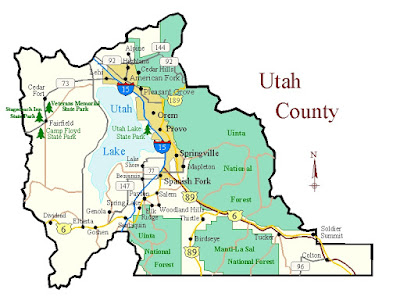I went to a neighborhood (someone’s backyard) “Meet the Candidate”
event in American Fork. The host was knowledgeable about the issues and
explained anything he thought people might not know about. He explained the difference about infrastructure and quality of life issues. Infrastructure is the basic structures and facilities (airports, internet, waste, irrigation, transportation, housing, schools, water, roads, power, etc) needed for the operation of a city.
Pleasant Grove city has a road problem, there is a proposition on the General Election ballot for Pleasant Grove citizens to vote for. "Proposition # 3 Shall Pleasant Grove City enact an ordinance requiring the transfer every year of TWO MILLION SIX HUNDRED TWENTY FIVE THOUSAND DOLLARS ($2,625,000.00) from the General Fund to fund road repair and maintenance as the primary budget priority? Road repair and maintenance would be funded before other general fund services which include: library, parks, swimming pool, cultural arts, and senior citizen services. FY 2017 General Fund Budget is $12,581,333.00, the required transfer represents a 20.86% budget reduction for general fund services without additional funding. The ordinance states services other than roads could be funded by pursuing tax increases or other means."
From the Daily Herald, "According to a recent engineering study, the city would need to spend $3.8 million per year on roads over a period of 20 years for the roads to be in good condition. Currently, $1.5 million is being spent annually on roads...City leaders released a fiscal impact statement, in response to the initiative, detailing which city services are in danger of being eliminated if the additional $2.3 million, about 18 percent of the general fund budget, is spent on roads. Services in danger of being eliminated include the library, swimming pool, parks and outdoor recreation programs, senior center, cultural arts and city celebrations."
When I went to the Pleasant Grove meet the candidates event, all the candidates I was able to talk to were against Prop 3 and they talked about adding a fee to the utility bill to fix the roads. Highland recently added an $18.50 per month transportation fee to their utility bill, after the failure of a citizen’s referendum to gather enough signatures to be put on the ballot. The Highland road fee has an ending deadline of June 30, 2028.
However, cities have been criticized for adding fees to utility bills instead of increasing property taxes. If property taxes are raised, then truth-in-taxation hearings will need to be held. Increasing utility fees are easier and ensures that tax-exempt organizations (for example, churches and hospitals, which Utah County has a high number of) pay their share of the cost of government. Rep. Jefferson Moss of Saratoga Springs and Sen. Howard Stephenson of Draper co-sponsored H.B. 164 Municipal Enterprise Fund Amendments in the 2017 legislative session, which requires a municipality that intends to transfer money from an enterprise fund to another fund to provide public notice of the intended transfer, clearly identify the intended transfer in the tentative budget or budget amendment, and hold a separate and independent public hearing.
Roads are something we all need, but those pesky pot holes after snow storms can be frustrating.
Pleasant Grove city has a road problem, there is a proposition on the General Election ballot for Pleasant Grove citizens to vote for. "Proposition # 3 Shall Pleasant Grove City enact an ordinance requiring the transfer every year of TWO MILLION SIX HUNDRED TWENTY FIVE THOUSAND DOLLARS ($2,625,000.00) from the General Fund to fund road repair and maintenance as the primary budget priority? Road repair and maintenance would be funded before other general fund services which include: library, parks, swimming pool, cultural arts, and senior citizen services. FY 2017 General Fund Budget is $12,581,333.00, the required transfer represents a 20.86% budget reduction for general fund services without additional funding. The ordinance states services other than roads could be funded by pursuing tax increases or other means."
From the Daily Herald, "According to a recent engineering study, the city would need to spend $3.8 million per year on roads over a period of 20 years for the roads to be in good condition. Currently, $1.5 million is being spent annually on roads...City leaders released a fiscal impact statement, in response to the initiative, detailing which city services are in danger of being eliminated if the additional $2.3 million, about 18 percent of the general fund budget, is spent on roads. Services in danger of being eliminated include the library, swimming pool, parks and outdoor recreation programs, senior center, cultural arts and city celebrations."
When I went to the Pleasant Grove meet the candidates event, all the candidates I was able to talk to were against Prop 3 and they talked about adding a fee to the utility bill to fix the roads. Highland recently added an $18.50 per month transportation fee to their utility bill, after the failure of a citizen’s referendum to gather enough signatures to be put on the ballot. The Highland road fee has an ending deadline of June 30, 2028.
However, cities have been criticized for adding fees to utility bills instead of increasing property taxes. If property taxes are raised, then truth-in-taxation hearings will need to be held. Increasing utility fees are easier and ensures that tax-exempt organizations (for example, churches and hospitals, which Utah County has a high number of) pay their share of the cost of government. Rep. Jefferson Moss of Saratoga Springs and Sen. Howard Stephenson of Draper co-sponsored H.B. 164 Municipal Enterprise Fund Amendments in the 2017 legislative session, which requires a municipality that intends to transfer money from an enterprise fund to another fund to provide public notice of the intended transfer, clearly identify the intended transfer in the tentative budget or budget amendment, and hold a separate and independent public hearing.
Roads are something we all need, but those pesky pot holes after snow storms can be frustrating.
